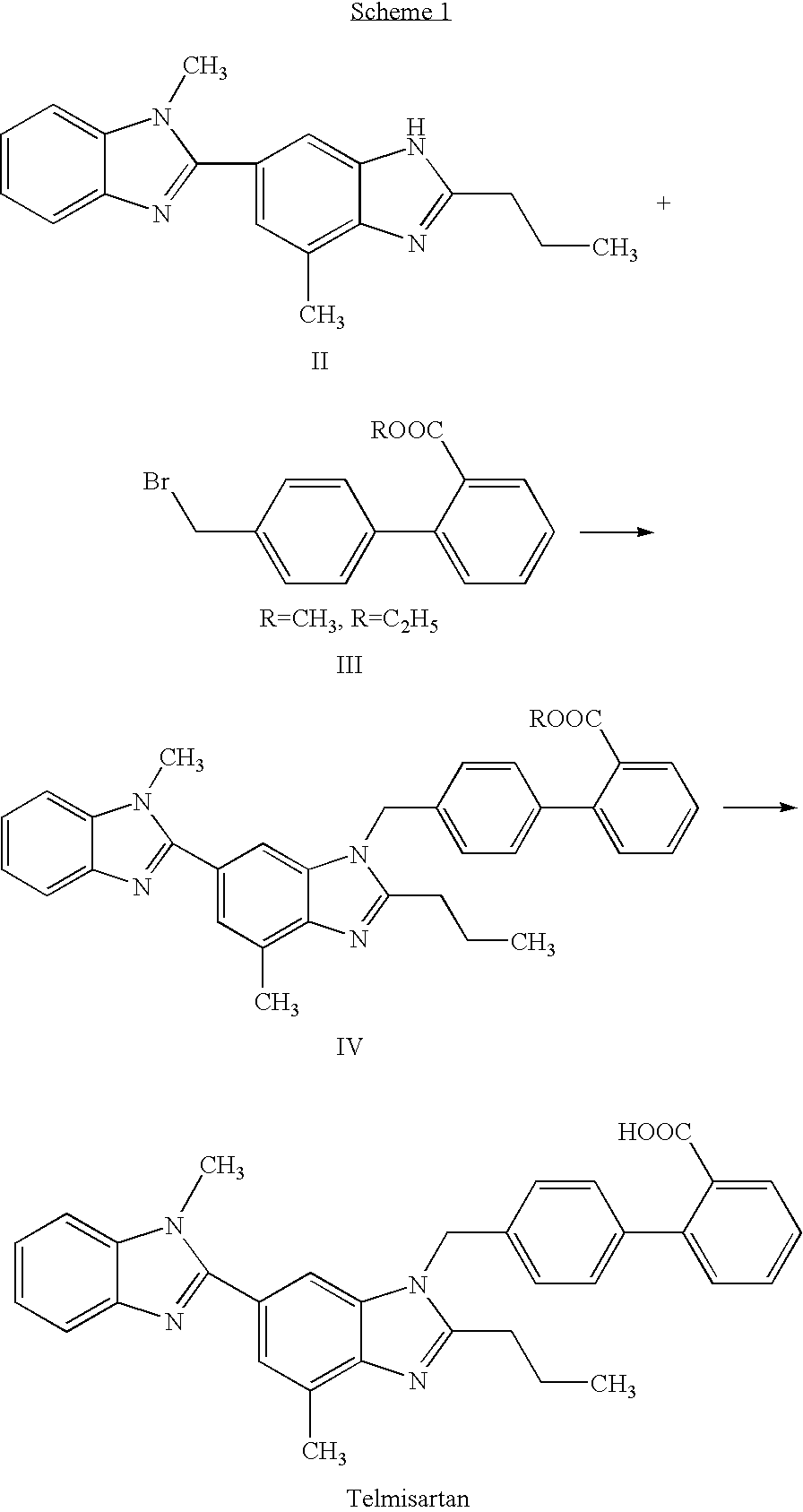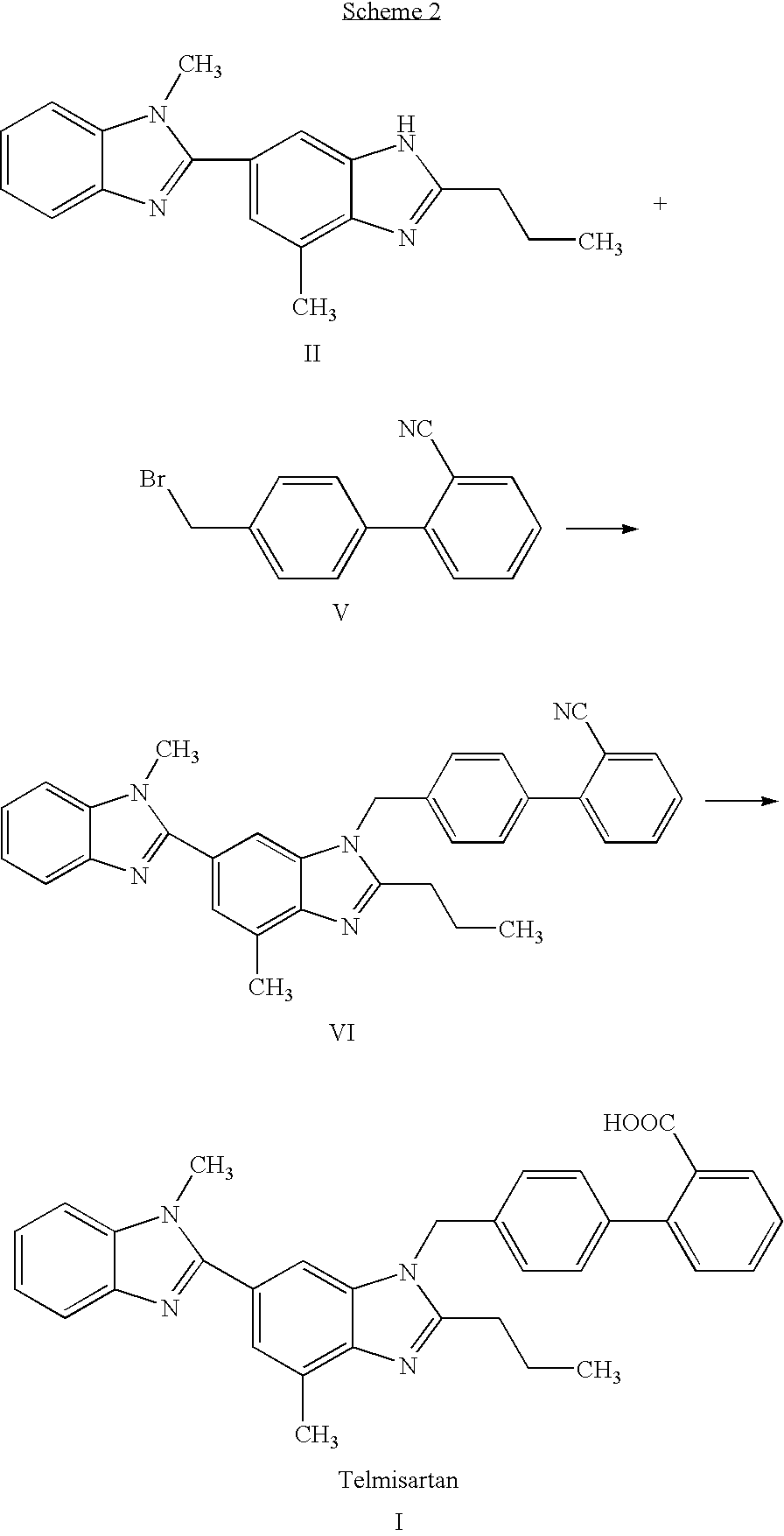Telmisartan production process
a technology of telmisartan and production process, which is applied in the field of telmisartan production process, can solve the problems of insufficient pharmaceutical purposes, and achieve the effect of high yield
- Summary
- Abstract
- Description
- Claims
- Application Information
AI Technical Summary
Benefits of technology
Problems solved by technology
Method used
Image
Examples
example 1
[0031] This example illustrates a method for preparing 4′-[(1,4′-dimethyl-2′-propyl [2,6′-bi-1H-benzimidazol]-1′-yl)methyl]-[1,1′- biphenyl]-2-carboxamide (compound VII).
[0032] A two-necked reaction vessel equipped with a reflux condenser and a thermometer was charged with 4′-[(1,4′-dimethyl-2′-propyl[2,6′-bi-1H-benzimidazol]-1′-yl)methyl]-[1,1′- biphenyl]-2-carbonitrile (compound VI) (5 g) and ethanol (40 ml). The reaction mixture was stirred at room temperature and 47% sodium hydroxide was added (2.34 ml) followed by water (20 ml), and the mixture was refluxed for 16 hours to afford a suspension. Then, the mixture was cooled to 25° C., stirred for 1 hour at 25° C. and then for 1 hour at 5° C. The thus formed solid was filtered off and washed with a cold mixture of 2 / 1 ethanol / water. The crystals were dried at 50° C. to afford 4.7 g of the desired product in 90% yield, having a purity of 98.9% (by HPLC).
example 2
[0033] This example illustrates a process for preparing Telmisartan.
[0034] A two-necked reaction vessel equipped with a reflux condenser and a thermometer was charged with compound VII (10 g), potassium hydroxide powder (10 g), and propylene glycol (100 ml). The reaction mixture was refluxed at a temperature of about 150° C. overnight. The majority of the propylene glycol was distilled off under vacuum and the mixture was cooled to 85° C. Water was added in portions to afford a solution and charcoal was added (0.5 g). Stirring was maintained for 15 minutes at 85° C. and the hot mixture was filtered through a Celite pad. The filtrate was transferred into a clean reaction vessel and a solution of acetic acid (9.2 ml) in water (20 ml) was added in portions at 85° C. Stirring was maintained for 15 minutes at 85° C. and the suspension was cooled to 25° C. Stirring was maintained for one hour at 25° C. and a solid was obtained by filtration. The solid was washed with water followed by ad...
example 3
[0035] This example demonstrates a process for crystallizing Telmisartan.
[0036] In a 500 ml three-necked round bottom flask equipped with a reflux condenser, a thermometer and a magnetic stirrer, crude Telmisartan (58.4 g) was suspended in DMF (293 ml). The suspension was heated to 90° C. using an oil bath, and left to cool down to 25° C. Mixing was maintained at this temperature for about an hour. Then, the mixture was cooled down to 5° C. and mixing was maintained at this temperature for about an hour. The solid was obtained by filtration, washed with cold ethanol and dried under vacuum to afford 47.9 g of the dried material in 82% yield, having a purity of 99.9% (by HPLC).
PUM
| Property | Measurement | Unit |
|---|---|---|
| temperature | aaaaa | aaaaa |
| temperature | aaaaa | aaaaa |
| temperature | aaaaa | aaaaa |
Abstract
Description
Claims
Application Information
 Login to View More
Login to View More - R&D
- Intellectual Property
- Life Sciences
- Materials
- Tech Scout
- Unparalleled Data Quality
- Higher Quality Content
- 60% Fewer Hallucinations
Browse by: Latest US Patents, China's latest patents, Technical Efficacy Thesaurus, Application Domain, Technology Topic, Popular Technical Reports.
© 2025 PatSnap. All rights reserved.Legal|Privacy policy|Modern Slavery Act Transparency Statement|Sitemap|About US| Contact US: help@patsnap.com



